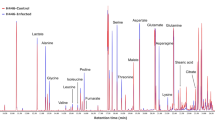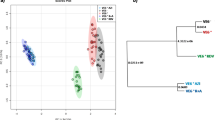Abstract
Viruses rely on the metabolic network of their cellular hosts to provide energy and building blocks for viral replication. We developed a flux measurement approach based on liquid chromatography–tandem mass spectrometry to quantify changes in metabolic activity induced by human cytomegalovirus (HCMV). This approach reliably elucidated fluxes in cultured mammalian cells by monitoring metabolome labeling kinetics after feeding cells 13C-labeled forms of glucose and glutamine. Infection with HCMV markedly upregulated flux through much of the central carbon metabolism, including glycolysis. Particularly notable increases occurred in flux through the tricarboxylic acid cycle and its efflux to the fatty acid biosynthesis pathway. Pharmacological inhibition of fatty acid biosynthesis suppressed the replication of both HCMV and influenza A, another enveloped virus. These results show that fatty acid synthesis is essential for the replication of two divergent enveloped viruses and that systems-level metabolic flux profiling can identify metabolic targets for antiviral therapy.
This is a preview of subscription content, access via your institution
Access options
Subscribe to this journal
Receive 12 print issues and online access
$209.00 per year
only $17.42 per issue
Buy this article
- Purchase on SpringerLink
- Instant access to full article PDF
Prices may be subject to local taxes which are calculated during checkout





Similar content being viewed by others
References
Fiehn, O. Metabolomics–the link between genotypes and phenotypes. Plant Mol. Biol. 48, 155–171 (2002).
Nicholson, J.K., Connelly, J., Lindon, J.C. & Holmes, E. Metabonomics: a platform for studying drug toxicity and gene function. Nat. Rev. Drug Discov. 1, 153–161 (2002).
Sauer, U. Metabolic networks in motion: 13C-based flux analysis. Mol. Syst. Biol. 2, 62 (2006).
Wikoff, W.R., Gangoiti, J.A., Barshop, B.A. & Siuzdak, G. Metabolomics identifies perturbations in human disorders of propionate metabolism. Clin. Chem. 53, 2037–2039 (2007).
Holmes, E. et al. Metabolic profiling of CSF: evidence that early intervention may impact on disease progression and outcome in schizophrenia. PLoS Med. 3, e327 (2006).
Sabatine, M.S. et al. Metabolomic identification of novel biomarkers of myocardial ischemia. Circulation 112, 3868–3875 (2005).
Kind, T., Tolstikov, V., Fiehn, O. & Weiss, R.H. A comprehensive urinary metabolomic approach for identifying kidney cancer. Anal. Biochem. 363, 185–195 (2007).
Rezzi, S. et al. Human metabolic phenotypes link directly to specific dietary preferences in healthy individuals. J. Proteome Res. 6, 4469–4477 (2007).
Bruggeman, C.A. Does cytomegalovirus play a role in atherosclerosis? Herpes 7, 51–54 (2000).
Reinhardt, B. et al. Human cytomegalovirus-induced reduction of extracellular matrix proteins in vascular smooth muscle cell cultures: a pathomechanism in vasculopathies? J. Gen. Virol. 87, 2849–2858 (2006).
Gerna, G., Baldanti, F. & Revello, M.G. Pathogenesis of human cytomegalovirus infection and cellular targets. Hum. Immunol. 65, 381–386 (2004).
Burny, W., Liesnard, C., Donner, C. & Marchant, A. Epidemiology, pathogenesis and prevention of congenital cytomegalovirus infection. Expert Rev. Anti Infect. Ther. 2, 881–894 (2004).
Myerson, D., Hackman, R.C., Nelson, J.A., Ward, D.C. & McDougall, J.K. Widespread presence of histologically occult cytomegalovirus. Hum. Pathol. 15, 430–439 (1984).
Browne, E.P., Wing, B., Coleman, D. & Shenk, T. Altered cellular mRNA levels in human cytomegalovirus-infected fibroblasts: viral block to the accumulation of antiviral mRNAs. J. Virol. 75, 12319–12330 (2001).
Furukawa, T., Fioretti, A. & Plotkin, S. Growth characteristics of cytomegalovirus in human fibroblasts with demonstration of protein synthesis early in viral replication. J. Virol. 11, 991–997 (1973).
Tanaka, S., Furukawa, T. & Plotkin, S.A. Human cytomegalovirus stimulates host cell RNA synthesis. J. Virol. 15, 297–304 (1975).
Landini, M.P. Early enhanced glucose uptake in human cytomegalovirus-infected cells. J. Gen. Virol. 65, 1229–1232 (1984).
Munger, J., Bajad, S.U., Coller, H.A., Shenk, T. & Rabinowitz, J.D. Dynamics of the cellular metabolome during human cytomegalovirus infection. PLoS Pathog. 2, e132 (2006).
Szyperski, T. Biosynthetically directed fractional C-13-labeling of proteinogenic amino-acids - an efficient analytical tool to investigate intermediary metabolism. Eur. J. Biochem. 232, 433–448 (1995).
Zhao, J., Baba, T., Mori, H. & Shimizu, K. Global metabolic response of Escherichia coli to gnd or zwf gene-knockout, based on 13C-labeling experiments and the measurement of enzyme activities. Appl. Microbiol. Biotechnol. 64, 91–98 (2004).
Boros, L.G., Brackett, D.J. & Harrigan, G.G. Metabolic biomarker and kinase drug target discovery in cancer using stable isotope-based dynamic metabolic profiling (SIDMAP). Curr. Cancer Drug Targets 3, 445–453 (2003).
Yuan, J., Fowler, W.U., Kimball, E., Lu, W. & Rabinowitz, J.D. Kinetic flux profiling of nitrogen assimilation in Escherichia coli . Nat. Chem. Biol. 2, 529–530 (2006).
Yuan, J., Bennett, B.D. & Rabinowitz, J.D. Kinetic flux profiling for quantitation of cellular metabolic fluxes. Nat. Protoc. 3, 1328–1340 (2008).
Frenkel, R. Regulation and physiological functions of malic enzymes. Curr. Top. Cell. Regul. 9, 157–181 (1975).
Chatham, J.C., Forder, J.R., Glickson, J.D. & Chance, E.M. Calculation of absolute metabolic flux and the elucidation of the pathways of glutamate labeling in perfused rat heart by 13C NMR spectroscopy and nonlinear least squares analysis. J. Biol. Chem. 270, 7999–8008 (1995).
Duarte, N.C. et al. Global reconstruction of the human metabolic network based on genomic and bibliomic data. Proc. Natl. Acad. Sci. USA 104, 1777–1782 (2007).
Bennett, B.D., Yuan, J., Kimball, E.H. & Rabinowitz, J.D. Absolute quantitation of intracellular metabolite concentrations by an isotope ratio-based approach. Nat. Protoc. 3, 1299–1311 (2008).
Feng, X.J. & Rabitz, H. Optimal identification of biochemical reaction networks. Biophys. J. 86, 1270–1281 (2004).
van Winden, W.A. et al. Metabolic-flux analysis of Saccharomyces cerevisiae CEN.PK113–7D based on mass isotopomer measurements of 13C-labeled primary metabolites. FEM Yeast Res. 5, 559–568 (2005).
Fishman, J.A. et al. Dosing of intravenous ganciclovir for the prophylaxis and treatment of cytomegalovirus infection in solid organ transplant recipients. Transplantation 69, 389–394 (2000).
Gibson, J.P. et al. Toxicity and teratogenicity studies with the hypolipidemic drug RMI 14,514 in rats. Fundam. Appl. Toxicol. 1, 19–25 (1981).
Abu-Elheiga, L. et al. Mutant mice lacking acetyl-CoA carboxylase 1 are embryonically lethal. Proc. Natl. Acad. Sci. USA 102, 12011–12016 (2005).
Abu-Elheiga, L., Matzuk, M.M., Abo-Hashema, K.A. & Wakil, S.J. Continuous fatty acid oxidation and reduced fat storage in mice lacking acetyl-CoA carboxylase 2. Science 291, 2613–2616 (2001).
Kariya, T. & Wille, L.J. Inhibition of fatty acid synthesis by RMI 14,514 (5-tetradecyloxy-2-furoic acid). Biochem. Biophys. Res. Commun. 80, 1022–1024 (1978).
Pizer, E.S., Chrest, F.J., DiGiuseppe, J.A. & Han, W.F. Pharmacological inhibitors of mammalian fatty acid synthase suppress DNA replication and induce apoptosis in tumor cell lines. Cancer Res. 58, 4611–4615 (1998).
Chambers, J. et al. DNA microarrays of the complex human cytomegalovirus genome: profiling kinetic class with drug sensitivity of viral gene expression. J. Virol. 73, 5757–5766 (1999).
Pizer, E.S. et al. Inhibition of fatty acid synthesis induces programmed cell death in human breast cancer cells. Cancer Res. 56, 2745–2747 (1996).
Lee, W.N. et al. Mass isotopomer study of the nonoxidative pathways of the pentose cycle with [1,2–13C2]glucose. Am. J. Physiol. 274, E843–E851 (1998).
Zupke, C., Sinskey, A.J. & Stephanopoulos, G. Intracellular flux analysis applied to the effect of dissolved oxygen on hybridomas. Appl. Microbiol. Biotechnol. 44, 27–36 (1995).
Chance, E.M., Seeholzer, S.H., Kobayashi, K. & Williamson, J.R. Mathematical analysis of isotope labeling in the citric acid cycle with applications to 13C NMR studies in perfused rat hearts. J. Biol. Chem. 258, 13785–13794 (1983).
Ishii, N. et al. Multiple high-throughput analyses monitor the response of E. coli to perturbations. Science 316, 593–597 (2007).
Andrei, G., De Clercq, E. & Snoeck, R. Novel inhibitors of human CMV. Curr. Opin. Investig. Drugs 9, 132–145 (2008).
van Meer, G. & Simons, K. Viruses budding from either the apical or the basolateral plasma membrane domain of MDCK cells have unique phospholipid compositions. EMBO J. 1, 847–852 (1982).
Schmidt, M.F. The transfer of myristic and other fatty acids on lipid and viral protein acceptors in cultured cells infected with Semliki Forest and influenza virus. EMBO J. 3, 2295–2300 (1984).
Conti, G., Portincasa, P. & Chezzi, C. Cerulenin inhibits production of mature virion particles in chick embryo fibroblasts infected by influenza A viruses. Res. Virol. 146, 141–149 (1995).
Kapadia, S.B. & Chisari, F.V. Hepatitis C virus RNA replication is regulated by host geranylgeranylation and fatty acids. Proc. Natl. Acad. Sci. USA 102, 2561–2566 (2005).
Wikoff, W.R., Pendyala, G., Siuzdak, G. & Fox, H.S. Metabolomic analysis of the cerebrospinal fluid reveals changes in phospholipase expression in the CNS of SIV-infected macaques. J. Clin. Invest. 118, 2661–2669 (2008).
Brass, A.L. et al. Identification of host proteins required for HIV infection through a functional genomic screen. Science 319, 921–926 (2008).
Loftus, T.M. et al. Reduced food intake and body weight in mice treated with fatty acid synthase inhibitors. Science 288, 2379–2381 (2000).
Tong, L. & Harwood, H.J., Jr. Acetyl-coenzyme A carboxylases: versatile targets for drug discovery. J. Cell. Biochem. 99, 1476–1488 (2006).
Warburg, O. On the origin of cancer cells. Science 123, 309–314 (1956).
Bauer, D.E., Hatzivassiliou, G., Zhao, F., Andreadis, C. & Thompson, C.B. ATP citrate lyase is an important component of cell growth and transformation. Oncogene 24, 6314–6322 (2005).
Yu, D., Smith, G.A., Enquist, L.W. & Shenk, T. Construction of a self-excisable bacterial artificial chromosome containing the human cytomegalovirus genome and mutagenesis of the diploid TRL/IRL13 gene. J. Virol. 76, 2316–2328 (2002).
Bajad, S.U. et al. Separation and quantitation of water soluble cellular metabolites by hydrophilic interaction chromatography-tandem mass spectrometry. J. Chromatogr. A. 1125, 76–88 (2006).
Luo, B., Groenke, K., Takors, R., Wandrey, C. & Oldiges, M. Simultaneous determination of multiple intracellular metabolites in glycolysis, pentose phosphate pathway and tricarboxylic acid cycle by liquid chromatography-mass spectrometry. J. Chromatogr. A. 1147, 153–164 (2007).
Varnum, S.M. et al. Identification of proteins in human cytomegalovirus (HCMV) particles: the HCMV proteome. J. Virol. 78, 10960–10966 (2004).
Silva, M.C., Yu, Q.C., Enquist, L. & Shenk, T. Human cytomegalovirus UL99-encoded pp28 is required for the cytoplasmic envelopment of tegument-associated capsids. J. Virol. 77, 10594–10605 (2003).
Munger, J., Yu, D. & Shenk, T. UL26-deficient human cytomegalovirus produces virions with hypophosphorylated pp28 tegument protein that is unstable within newly infected cells. J. Virol. 80, 3541–3548 (2006).
Acknowledgements
This work was supported by the National Institutes of Health (NIH) Metabolomics Roadmap initiative (AI068678), NIH grants CA82396 and CA85786, and the NIH Center for Systems Biology at Princeton University (5 P50 GM071508). Development of the fluxomic technology was supported by the National Science Foundation Faculty Early Career Development award program (MCB-0643859), the Beckman Foundation, the American Heart Association (0635188N) and the National Science Foundation Dynamic Data-Driven Applications Systems program (CNS-0549181). J. Munger was supported by a postdoctoral fellowship from the American Cancer Society.
Author information
Authors and Affiliations
Contributions
J. Munger conducted experiments, analyzed data, conceived ideas and prepared the manuscript; B.D.B. conducted experiments, analyzed data, conceived ideas and prepared the manuscript; A.P. analyzed data; X.-J.F. conceived ideas and analyzed data; J. McArdle conducted experiments and analyzed data; H.A.R. conceived ideas; T.S. conceived ideas and prepared the manuscript; and J.D.R. conceived ideas, analyzed data and prepared the manuscript.
Corresponding author
Supplementary information
Supplementary Text and Figures
Figures 1–5, Tables 1–10, Methods, Computational Code (PDF 3088 kb)
Rights and permissions
About this article
Cite this article
Munger, J., Bennett, B., Parikh, A. et al. Systems-level metabolic flux profiling identifies fatty acid synthesis as a target for antiviral therapy. Nat Biotechnol 26, 1179–1186 (2008). https://doi.org/10.1038/nbt.1500
Received:
Accepted:
Published:
Issue Date:
DOI: https://doi.org/10.1038/nbt.1500



